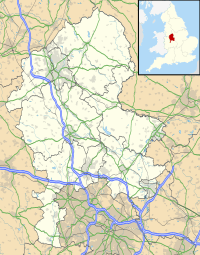Catholme ceremonial complex facts for kids
| Location | Near Barton-under-Needwood, Staffordshire |
|---|---|
| Coordinates | 52°44′52″N 1°42′43″W / 52.74778°N 1.71194°W |
| Type | Henge enclosure Timber circle Pit alignments |
| History | |
| Periods | Neolithic |
| Designated | 8 December 1999 |
| Reference no. | 1019109 |
The Catholme ceremonial complex is an amazing ancient site. It is located in Staffordshire, England, near Barton-under-Needwood. People built this complex during the Stone Age. It is now a special protected place called a scheduled monument.
Contents
What is the Catholme Complex?
This ancient site is found near the River Trent in Staffordshire. It is close to where the Trent meets two other rivers. You cannot see the complex on the ground today. But from an airplane, you can see patterns in the fields. These patterns are called cropmarks. They show where old structures are hidden underground.
The Giant Wooden Circle
Archaeologists found traces of a huge wooden circle here. It was made from about 225 large wooden posts. These posts were placed in five circles, one inside the other. The whole circle was about 50 meters (164 feet) wide. This wooden circle was built in the late Stone Age. It is similar to other famous ancient sites. These include parts of Durrington Walls near Stonehenge.
The "Sunburst" Monument
About 200 meters (656 feet) west of the wooden circle is another monument. It is called the "sunburst" monument. This monument is a small henge enclosure. A henge is a circular area with a ditch around it. This one is about 17 meters (56 feet) wide. It has 12 lines of postholes outside its ditch. These lines look like rays of sunshine, giving it the "sunburst" name. The whole "sunburst" area is about 60 meters (197 feet) wide.
Long Lines of Pits
To the north and south of these main monuments are long lines of pits. These lines stretch for over 1 kilometer (0.6 miles). They run from west to east across the land.
How Was the Site Discovered and Studied?
Experts from Birmingham Archaeology studied the site. They worked there from 2002 to 2004. They used special tools like geophysical surveys and Lidar. These tools help them "see" what is underground. They also did some digging, called excavation.
Building Over Time
Their studies helped them understand how the complex was built. The radiating pit lines of the "sunburst" monument might be the oldest parts. The circular ditch was added later. Around 2500 BC, the ditch was changed into a segmented enclosure. The large wooden circle, with its tall oak posts, was also built around this time.
A Special Burial
About 500 years later, something new happened. Someone was buried right in the center of the "sunburst" monument. They were buried with special items. These items included Beaker pottery, which is a type of ancient pot. The long pit lines to the north and south were likely built later. They might be from the late Bronze Age. It seems they were placed carefully to respect the older monuments.


